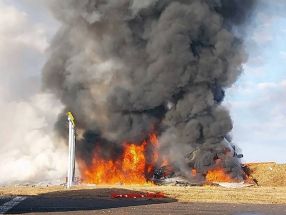South African desert to host speed record bid
JOHANNESBURG (AP) — Toiling with shovels, wheelbarrows and bare hands, about 300 workers removed 6,000 tons of stones and other debris from a vast stretch of desert in a desolate corner of South Africa over the past two years. If all goes well, it will become the place where a British-led team tries to breaks the world land-speed record.
"It will be a brisk ride," said Andy Green, the man who plans to break his own record in 2015, using a vehicle powered by rocket and warplane technology. His goal? Reaching 1,610 kilometers (1,000 miles) an hour.
The track of hard-packed earth at the Hakskeen Pan, tucked between Namibia and Botswana, is 1.1 kilometers (0.7 miles) wide and 20 kilometers (12.5 miles) long. It could rival Black Rock Desert in Nevada, where Green clocked 1,228 kilometers (763 miles) an hour and broke the sound barrier in 1997, and the Bonneville Salt Flats in Utah as the premier temple of speed in the world.
Clearing and scraping the track was a monumental task for the laborers, who plan to contact the Guinness World Book of Records in hopes their achievement will be recognized as the biggest area of land ever cleared by hand. They came from surrounding villages where unemployment is high, and the Northern Cape provincial government paid most of the workers an $11 daily wage, a standard amount for public works projects in the region.
Peter McKuchane, head of business tourism for the province, said the goal after Green's record bid is to transform the track into a tourist site in an area where people barely get by on livestock farming. Already, last year, races were held in the area.
Every meter will be scanned by laser to ensure smoothness.
"Flicking a stone up with the front wheels and hitting the rear wheels would be like being shot with a supersonic bullet. That would be enough to punch a hole in pretty much anything," Green said. "So we could destroy the car just by hitting the debris lying on the surface, never mind all the damage you would actually do to the wheels, rolling over."
Green chose Hakskeen Pan after a worldwide search. He found Hakskeen secure and accessible. Also, the vehicle's wheels are believed to perform better on the dried mud than on the salt flats of Bonneville and, according to Green, the surface at Black Rock has become rutted.
Speed is the ultimate measure of performance, and the quest to go faster than anyone is a fertile source of lore. Chuck Yeager was the first pilot to fly faster than sound, transforming him into a hero. Jamaican sprinter Usain Bolt brought down the house at the London Olympics with his three gold medals.
As with many British adventurers, 50-year-old Green brings an understated eccentricity to this elite class of speed demons. A mathematician and former Royal Air Force pilot, endowed with the title of Officer of the Order of the British Empire, he mused about the possible impact of billowing shock waves from his very fast car.
"One of the problems is working out how far back you, the media, and the general public all need to be so that as the car goes rushing past we don't have people exploding in its wake. It's a nice problem to have," Green said Tuesday in a news conference at the Johannesburg headquarters of South African telecommunications firm MTN, a sponsor.
Several teams on other continents are plotting to smash a record that the British have owned, off and on, over the past century. Green has the edge in sponsorship backing. His project has raised $24 million so far, and another $11 million might be needed.
His rivals are a flamboyant bunch.
"I'm probably a nutcase, I don't know," driver Rosco McGlashan said in a telephone interview from western Australia.
In Perth, McGlashan's band of self-described "speed freaks" are working on a 9-ton car, the "Aussie Invader 5R," that was in the planning for a decade before construction started. They plan to test the rocket engine later this year, and make a record attempt in 2014.
The North American Eagle team wants to restore the land-speed crown to the United States. The team cut the wings off a Lockheed F-104 Starfighter in hopes of turning it into the world's fastest car. The last American to set the record was Gary Gabelich at Bonneville in 1970.
"I expect to be the one in the cockpit unless my team deems me to be insane, which my wife has already declared," Ed Shadle, North American Eagle driver, project manager and former IBM manager, wrote in an email. He said the project is fun but frustrating, slowed partly by funding challenges.
These thrill seekers are thinkers too, precise and patient.
At Black Rock 15 years ago, Green drove the Thrust SSC, a black, jet-propelled car that wedded Batmobile menace with space rocket chic. Today it sits in a museum. Technology has come a long way since then.
Now Green and his design team are working on the aluminum-wheeled Bloodhound SSC (SuperSonic Car), powered by a military jet engine from the Eurofighter Typhoon aircraft along with a hybrid rocket motor to propel the engine to maximum speed. The namesake of the slender vehicle is a British missile built in the 1950s.
The team plans to crack 1,610 kilometers (1,000 miles) an hour in 55 seconds, with another minute to slow down with parachutes and other brake systems. The extreme push and pull sends blood rushing from feet to head and back again. Veteran pilots have lost consciousness under such stress.
A long time ago, the French monopolized land speed. Count Gaston de Chasseloup-Laubat recorded a then-impressive 63.15 kilometers (39.24 miles) an hour in an electric-powered car near Paris in 1898. Then came steam power, the internal combustion engine and, later, jet propulsion and rockets.
A car seeking to break the speed record must have a driver and four or more wheels. The Paris-based FIA, the governing body of motor sport, oversees results.
The Bloodhound will carry 16 cameras, allowing the world to watch the event in real time. The aim, besides the thrill and the entry in the record books, is to encourage young people into becoming scientists and engineers, Green said.
"At the end of the day, impressing the 12-year-old girl about science and technology is not going to happen if we have a massive crash," Green said. "It gets a lot of YouTube hits, but it won't leave the legacy of, 'Isn't science cool?' It will leave the legacy of, 'Aren't they stupid?'"
- Latest
- Trending


























